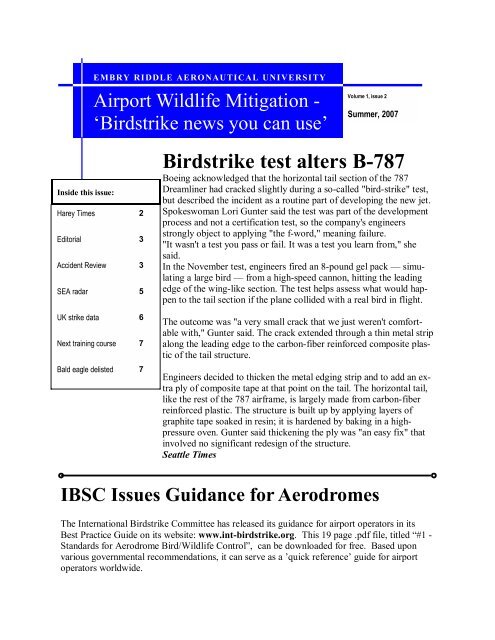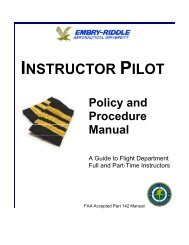Birdstrike test alters B-787 - FAA
Birdstrike test alters B-787 - FAA
Birdstrike test alters B-787 - FAA
You also want an ePaper? Increase the reach of your titles
YUMPU automatically turns print PDFs into web optimized ePapers that Google loves.
EDITORIAL EAGLE EYESNever let it be said that our readers are not eagle eyed. In our first edition we mentioned‘...training for wildlife biologists who write plans…’ only to hear, loudly, from the regulatorsthat biologists don’t write airport wildlife plans, airports do. Biologists write wildlife hazardassessments. Well, obviously airports don’t write plans, either, airports being entities withoutfingers to tap the keyboards. What the regulators are trying to say is that the airport has to takeownership of its wildlife plan, have a responsible airport executive sign the plan and then seethat it is implemented.In another gaffe, we cited Tersan and Benomyl as control products for earth worms. They areno longer listed and not available for this use. The only insecticide available is Sevin, a widespectrum product with its own problems. Perhaps some research into earth worm control is inorder?In any event keep those cards, letters, emails and spitballs coming. It will keep us honest.Paul Eschenfelder - EditorAvion Corp.Eschenfelder@compuserve.comACCIDENT REVIEWPau, FranceOur last newsletter reported on the crash, which killed a passenger in a nearby vehicle, of an AirFrance Fokker 50 jet in Pau. Press reports included a comment by a crew member that the aircraftflew through a flock of birds on takeoff, leading to the speculation that bird ingestion hadcaused the aircraft to lose thrust and crash.Further investigation has revealed that there was no bird ingestion damage to either of the engines.Given the fact that the airplane was unable to climb (never really became airborne) andthe wintry conditions prevailing at the time of the accident, it appears much more likely to be anicing caused accident.USAF T-38 CRASHThe USAF T-38, a twin engine training jet, which crashed in northern Mississippi in Januarywas initially believed to have encountered a flock of Canada geese.Cited in the Air Force Times the Accident Investigation Board now believes that the aircraft,valued at $6 million, struck a flock of mallard ducks. The aircraft was part of a two ship(cont’d page 4)
(T-38 cont’d from page 3)low level training mission. The mishap aircraftstruck the ducks on the nose, causing the canopy tofail. Pieces of the canopy went into both engines,causing power loss or failure of both engines. Theinstructor pilot concluded the aircraft could nolonger fly and ordered an ejection by both pilots.“...causing power loss or failure ofboth engines….”Speaking of dual engine ingestions…..• Rome- July 2007— Delta B-767-400, on departure, ingested yellow legged gulls intoboth engines just after liftoff. One engine severely damaged, other engine minor damage.Safe return to land.• Chicago— March 2007—United B767-300, on departure, ingested ducks just after liftoff.One engine destroyed (spectacular night video of engine on fire by amateur photographer),other engine with bird remains. Safe return to land.• Washington Dulles— March 2006— A-320, on landing, struck large flock of starlings.Over 270 dead birds found on runway. Both engines damaged by ingestion.Anybody want to go flying?BSC-Canada is sponsoring the 2007 Bird Strike Conference to be held September 10-13 inKingston, Ontario.The preliminary agenda is posted at: http://www.birdstrikecanada.com/Hotel reservations are due no later than July 30th, after which reservations can no longer beguaranteed. Registration and hotel booking forms are available on the website.
SEATAC Tests Bird RadarIn 2006, SEA was selected as the civilian airport to conduct the multi-year study fundedthrough the <strong>FAA</strong>’s Research and Development Branch, Atlantic City, New Jersey. The <strong>FAA</strong> isinterested in a study that will apply scientific rigor to the development and <strong>test</strong>ing of shortrangedradar hardware and its supporting bird detection algorithms. The SEA radar is uniquefrom others in that it’s comprised of two radars, the Accipiter® AR-2, compared to the one radarnode being <strong>test</strong>ed at DOD sites. The Accipiter® AR-2 will is expected to collect bird movementdata out to 5 miles while sampling both the lower and upper altitudes (up to 3000 ft).The Accipiter® AR-1 was successfully operated from the rooftop of the SEA Airport OfficeBuilding for two weeks in March 2007. Thepurpose of this trial was to verify that this locationoffered minimal interfering radar “clutter”and to <strong>test</strong> for potential interference with the<strong>FAA</strong>’s ASDE-X ground radar system. With thesuccess of this first phase, the final design wascompleted and approved in time for a June constructiondate.Most radar <strong>test</strong>s will be conducted with littleadditional effort by the Port of Seattle. To determinethe strengths/limitations of the radarhardware and detection software relative to distancefrom the airport, fixed objects such asMylar balloons, falconry, and remote controlledaircraft will be visually monitored concurrentlywith radar sampling. A mobile Accipiter® AR-1 on a trailer will also be used in this evaluationphase which is expected to continue for twoyears.The Accipiter® AR-2 is considered the optimal method for collecting data on wildlife use overa growing number of storm water facilities around SEA. The results of this study will help thePort of Seattle finalize its wildlife hazard mitigation BMP. The USDA-Wildlife Services hadoriginally planned to conduct this study until it was known SEA was selected as the demonstrationairport for this new radar system. Even if the Accipiter® AR-2 only meets its lower rangeof expectations, it will still allow more, and in many ways, better data to be collected comparedto the human observer which is limited to daylight observations.This collaborative effort is being conducted with funding from a <strong>FAA</strong> R&D grant through Dr.Ed Herricks at the <strong>FAA</strong> Center of Excellence in Airport Technology, University of Illinois -Urbana. Both SEA radars have been leased through Sicom Systems Ltd., Ontario, Canada. Installationand operational support will be provided by the Port of Seattle.For more information contact SEA biologist Steve Osmek; osmek.s@portseattle.org
UK Study Shows Mandatory ReportingIncreases Strike ReportsA recent studycommissionedby the UK’sCAA has determinedthat the2004 change inregulations requiringreportingof all bird strikesto aircraft ratherthan those strikescausing‘significant’damage orthought to pose asafety threat hasincreased thenumber of reports submitted by airports and aircraft operators.The CAA had been concerned that the reporting level was deteriorating and that the new mandatewould assure a proper and more accurate level of reporting.The report makes a number of recommendations to improve the completeness and accuracy ofreporting of birdstrikes, including improved communication and the sharing of informationwith Industry; improvements to the reporting system; clarification of the objectives of the reportingsystem and the interpretation of reports; and the obligations on Industry.The entire report can be viewed online at: www.caa.co.uk/docs/33/2006_05.pdf.Aviation Week & Space Technology
Bald Eagle Delisted!On June 28, 2007, Secretary of the Interior Dirk Kempthorneannounced the removal of the bald eagle from the list ofthreatened and endangered species. After nearly disappearingfrom most of the United States decades ago, the bald eagle isnow flourishing across the nation and no longer needs the protectionof the Endangered Species Act.However, bald eagles are still protected by the Bald and Golden Eagle Act and the MigratoryBird Treaty Act. The Eagle Act (16 U.S.C. 668-668c), enacted in 1940, and amended severaltimes since then, prohibits anyone, without a permit issued by the Secretary of the Interior,from "taking” bald eagles, including their parts, nests, or eggs.Bald eagles may now be treated like other protected birds. USF&WS permits, along with applicablestate permits, will be necessary prior to harassing or taking eagles.NEXT WILDLIFE HAZARD TRAINING SESSIONEmbry-Riddle has scheduled its next Airport Wildlife Management seminar in Seattle on October17-19, 2007. This is a change from the previously announced date.This seminar is acceptable to the <strong>FAA</strong> Administrator to fulfill the <strong>FAA</strong>’s training requirementsfor airport personnel supervising wildlife control on airports, airport personnel’s annual trainingrequirement and the training requirement for biologists who wish to conduct airport wildlifeassessments or write airport mitigation plans.The seminar is three days in length. The first two days consist of classroom sessions led byfour of the nation’s top wildlife management experts. These sessions allow for plenty of interactionwith the instructors, opportunities for questions and networking with fellow participants.Day three features a field trip to the host airport, during which hands-on wildlife mitigation exerciseswill be performed and mitigation techniques discussed.Participants who successfully complete the seminar will receive a certificate of completion andcontinuing education units (CEU) from Embry-Riddle Aeronautical University.You may register online at Embry-Riddle’s website http://www.erau.edu/ec/soctapd/wildlifeseattle.html or call 866-574-9125 for more information. Hotel reservations may bemade at the Holiday Inn SEATAC, 206-248-1000, ask for the Embry Riddle Airport WildlifeSeminar rate.
















